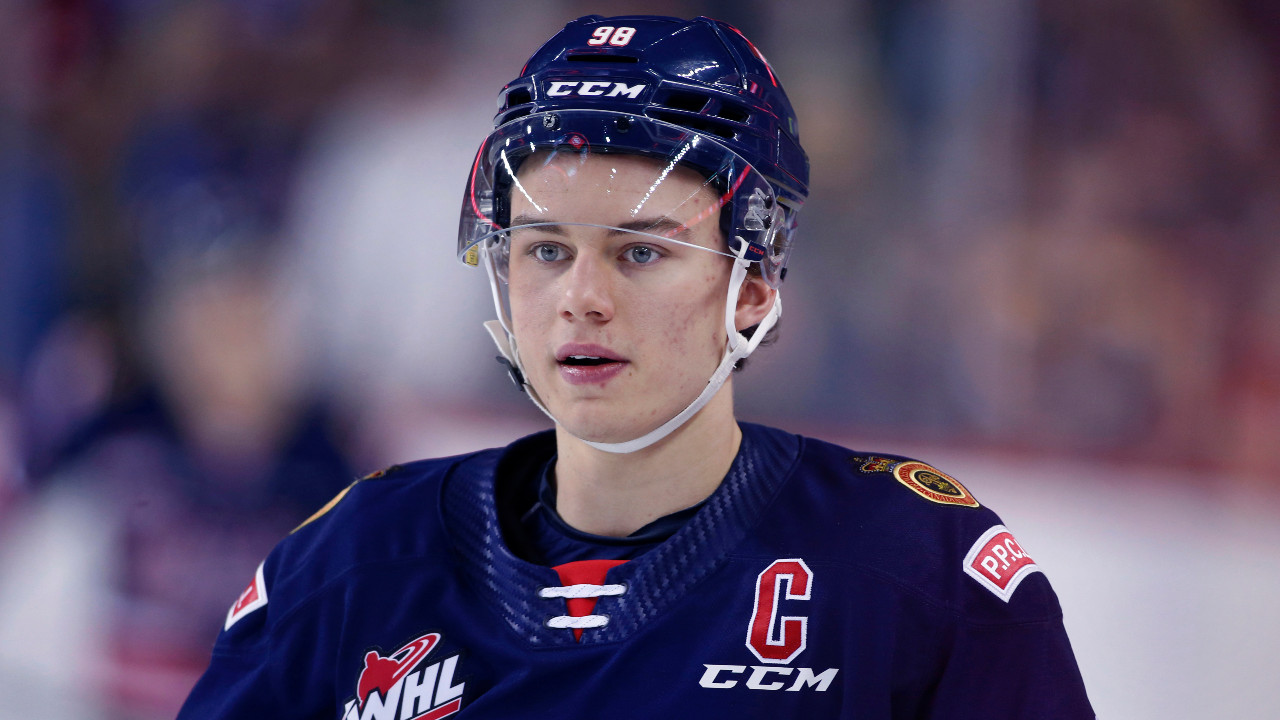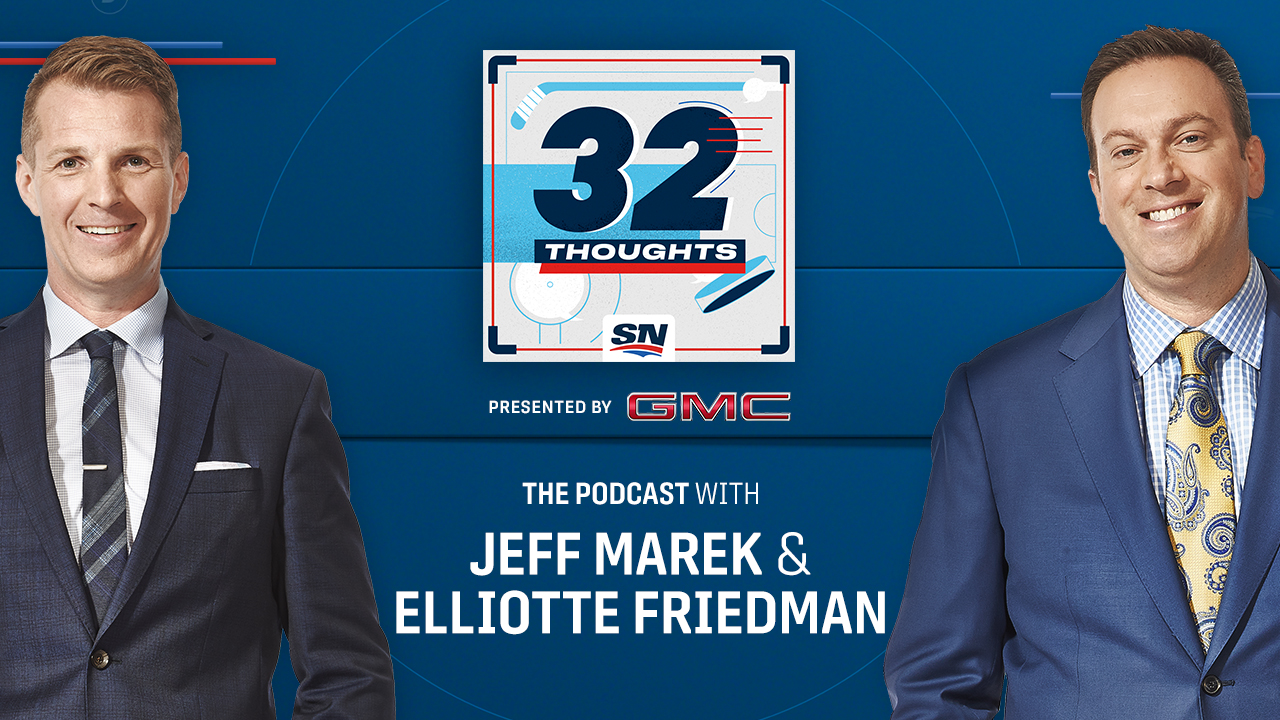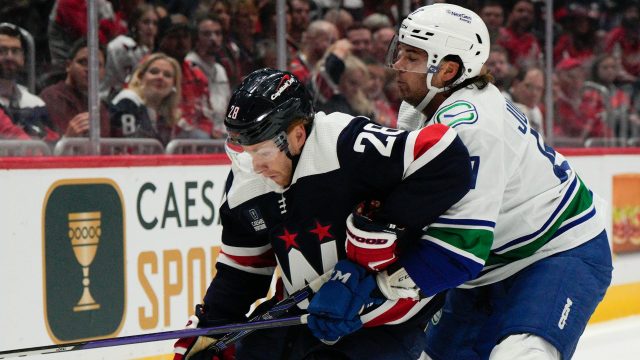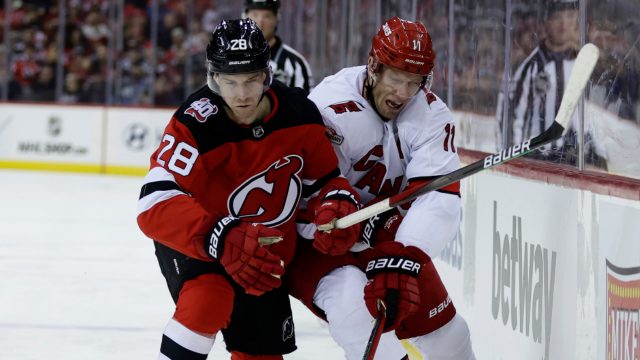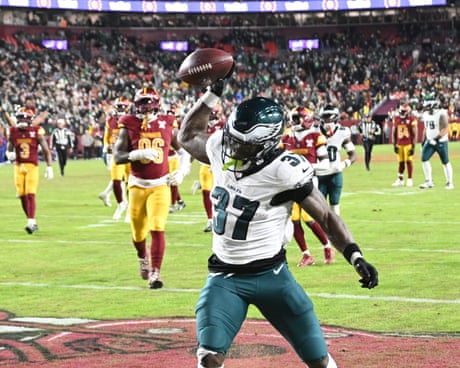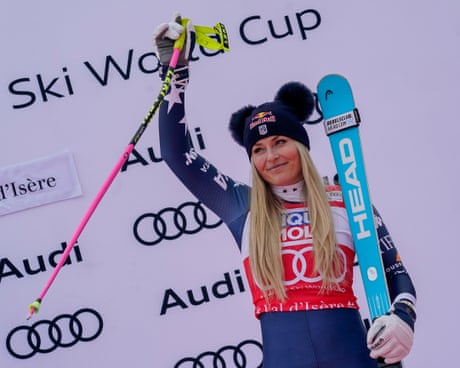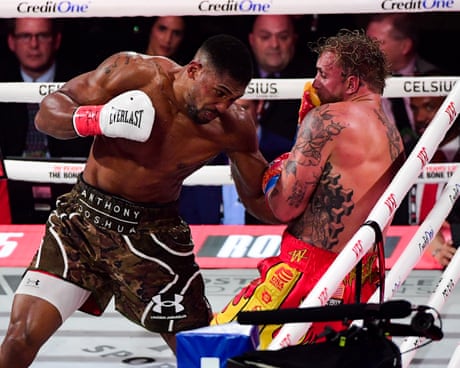
Next week the NHL will descend on Nashville, first for the awards on Monday and then into the draft on Wednesday and Thursday.
At that time, everyone will be under the same roof and you know trade talks will kick into high gear. With free agency returning to its July 1 opening, just two days after the draft concludes, teams may want to head into the spending spree with big transactions already out of the way.
Of course, some of this could go on into the summer months, too.
The trade season really has already kicked off, led by Columbus upgrading its D-corps with Damon Severson and Ivan Provorov, both of whom were on our most recent trade list from May. But we’re just getting started.
More trades could start rolling at any time now, so with some huge days on the NHL calendar coming up in the very near future, here’s our latest look at 22 trade candidates to keep an eye on.
John Gibson, Anaheim Ducks
It wouldn’t be an off-season trade candidates list without this name on it. Gibson has been a yearly trade candidate for a while now, but his contract ($6 million AAV through 2026-27), declining numbers from his peak (on a rebuilding team, we should mention) and his importance to the Ducks vs. how goalies are generally valued on the trade market are among the reasons he hasn’t moved. At GM Pat Verbeek’s end-of-season media conference, he said he wasn’t planning on trading his No. 1 goalie, but if a market stirs up for the soon-to-be 30-year-old the rebuilding Ducks surely would consider it. It’s believed the player is open to a change of scenery as well. The question any acquiring GM has to wrestle with, though, is if Gibson’s downward statistical trajectory has more to do with the team in front of him than his own play.
Clayton Keller, Arizona Coyotes
Things are getting even rockier in Arizona after Tempe locals voted against a new arena project in a referendum. Now, there really is no off-ice plan ahead in the market, and the on-ice plan could be affected. Top prospect Logan Cooley decided to stay another year in the NCAA, a choice that was impacted by the arena vote. Keller, the team’s top scorer, had his agents meet with the Coyotes to discuss the organization’s future, though it’s not believed he’s asked for a trade yet. Keller has five years left with an AAV of $7.15 million. “St. Louis has made a lot of noise about being willing to do things, but they haven’t done anything major yet. You would be foolish to think they won’t be doing something,” Elliotte Friedman said on this Monday’s 32 Thoughts podcast. “They’re waiting to see if there’s any chance a Keller becomes available. That’s a natural match because he’s a St. Louis guy and that’s where he’s from.”
Elias Lindholm, Calgary Flames
Lindholm didn’t exactly commit to the Flames at his year-end press conference, and new GM Craig Conroy said he wouldn’t allow another Johnny Gaudreau situation to happen where a top player walks out the door for nothing. At the same time, perhaps the situation has changed with Darryl Sutter being replaced behind the bench by Ryan Huska. Will Lindholm sign an extension over these next two weeks to keep himself in Calgary (and is that number around $8.5 million?) or will Conroy trade one of his best players? Eric Francis wrote recently that it was about to get really interesting with Lindholm and this next Flame…
Noah Hanifin, Calgary Flames
Another player one year away from free agency, as Elliotte Friedman recently noted “there’s a feeling out there that Hanifin is going to be available.” If Hanifin’s not going to re-sign then Conroy has another important player to try and recoup assets for. One of the more well-rounded defencemen in the league and a really sturdy defensive presence, Hanifin comes at a cost less than $5 million for now, but his future extension might be a factor.
Brett Pesce, Carolina Hurricanes
There’s one year remaining on Pesce’s $4.025 million contract and if he doesn’t ink an extension this summer, then the Hurricanes will explore the trade market. A solid second pair defenceman, Pesce should have a strong market for his services and indeed many teams (including Edmonton and Buffalo) have been linked to him in rumours already. The Canes pride themselves on having a strong blue line, but a Pesce extension would have to fit within a salary structure that includes Jaccob Slavin ($5.3 million), Brent Burns ($5.28 million) and Brad Skjei ($5.25 million), the last of whom also is entering the final year of his contract. If no deal with Pesce can be found, might the Canes flip him to try and further address their need for goal scoring?
Kailer Yamamoto, Edmonton Oilers
With eyes squarely on a Stanley Cup run, GM Ken Holland has to find ways to upgrade his team, whether it’s near the top of the lineup in the second line right wing spot, or in the depth roles. To do that, Holland must first find some salary cap space to work with, which is why finding a taker for Yamamoto’s $3.1 million cap hit is a top priority. Will someone take that contract off Edmonton’s books, or will rivals instead insist on Warren Foegele being the target to acquire? Foegele is a better fit with Edmonton’s needs in the bottom six, while Yamamoto is still just 24 and was a 20-goal scorer a year ago. The cost to acquire probably won’t be that great (Edmonton’s real pick up will be the cap room), so will some team take a shot on his potential?
Juuse Saros, Nashville Predators
Big goalie trades are fun to think about, but the fact is that they so rarely happen. This summer there are plenty of names rumoured to be available in trade, and we explored just how deep the pool of netminders could be this summer, depending on your taste. That smells like a buyer’s market and, if it is, will the offerings be big enough to pry a stud like Saros out of Nashville? While there could be many options available in trade or free agency at the position, Saros may have the best mix of performance, age (28) and contract appeal ($5 million for two more seasons). Those factors are what will also make the asking price absurdly high from new GM Barry Trotz, who sure would make his stamp on the organization from the GM’s seat with a move like this one.
Yegor Sharangovich, New Jersey Devils
There are some big contracts to figure out in New Jersey this summer, and one of them is out of the way with Jesper Bratt extended. Next could be Timo Meier, who Devils GM Tom Fitzgerald said was interested in signing for the maximum eight years. When the dust settles there, Fitzgerald will have a better idea on what he can do with Sherangovich, a 13-goal player down from 24 in 2021-22. He’s an RFA heading to arbitration and if that number ends up in a place that doesn’t align with Fitzgerald’s cap setup, Sherangovich could become a trade asset that another team sees upside in.
Alexis Lafreniere, New York Rangers
Three years into his NHL career, Lafreniere was never offered the immediate sort of big-role opportunity that usually goes to first-overall picks, and a lot of that had to do with situation. A left winger, Lafreniere was drafted to an organization that already had Chris Kreider and Artemi Panarin at the position, so Lafreniere has mostly settled into a third-line spot with a couple other youngsters, and not a ton of power-play time. The Rangers are in win-now mode and, after a disappointing first-round exit to rival New Jersey, might ponder swapping a high-end young asset for an area of greater need. Lafreniere’s entry-level contract is over, so the Rangers are left to make some sort of decision on the RFA: long-term deal, bridge deal or finding a deal with another team.
Alex DeBrincat, Ottawa Senators
DeBrincat was a huge addition for Ottawa last summer, but after a season in which he scored 27 goals (down from 41 the season prior) and is now due a hefty extension as an RFA, it might be hard for the Sens to get back a return that equals what they gave up for him (seventh overall pick, 39th overall pick and a 2024 third-rounder). DeBrincat is a year away from being a UFA, too, so whoever is interested in acquiring him may first want to understand if an extension is possible or not. In the meantime, there’s still plenty that hangs over Ottawa after Michael Andlauer’s purchase of the team. GM Pierre Dorion and head coach D.J. Smith both face questions about their futures, though a resolution on DeBrincat may need to happen before Andlauer gets BOG approval to make things official.
Travis Konecny, Philadelphia Flyers
Whether a full and proper rebuild transpires here under Keith Jones and Daniel Briere remains to be seen, but the Flyers are surely in for some change in direction on the ice. And it can’t all be “bad” contracts or “frustrating” players who get moved out — if you want something, you gotta give something up. Konecny has been loosely tied to trade rumours at recent trade deadlines, but the team has been reticent to move on too early from the now-26-year-old. He became more than a point per game player for the first time this past season and set a career high with 31 goals. He also makes just $5.5 million against the cap for another two years, which is great value for the team that has him. So, while the Flyers might still be interested in having Konecny as a core piece, he may also be an asset they use to really shift gears.
Scott Laughton, Philadelphia Flyers
If the new regime decides Konecny is one to keep, then perhaps the focus turns to dealing Scott Laughton. While a rebuilding team would like to keep some veteran presence around its young players, the Flyers have to balance that with their need to build the organization back up differently. Laughton plays a valued position and comes at a very reasonable cost ($3 million cap hit) for another three years. “He’s a really good player. Teams are always looking for centres,” Friedman noted at the Stanley Cup Final. “In a perfect world I think they’d like to keep Laughton, but if they get the right price they’ll consider it.”
Erik Karlsson, San Jose Sharks
Several teams reportedly contacted the Sharks during the season about acquiring Karlsson, who is your Norris Trophy favourite and put together an offensive year for the ages in 2022-23. But trading an $11.5 million AAV in-season (especially when the charge runs through the 2026-27 season) was always going to be difficult. Now we enter into the summer months where teams are allowed to exceed the regular season salary cap by 10 per cent and player movement is more common. Karlsson has a no-move clause in his contract and is in complete control of the situation, but he’s also said that he wants to be chasing his first Stanley Cup at this stage of his career. It doesn’t seem the Sharks are on the same timeline as the 33-year-old, so the market could be wide. However, even though it’s easier to work around the cap in the off-season, other teams will still want San Jose to retain some of Karlsson’s cap hit — what will Grier be open to?
Colton Parayko, St. Louis Blues
Another name that popped up in the pre-deadline rumour mill who was never traded, Parayko’s name will come up again in the summer — and he won’t be the only St. Louis Blues defenceman. The Blues will be changing something this summer, have impactful players potentially available, and three first-round picks in a deeply talented draft. St. Louis has three defencemen signed long term to $6.5 million AAVs (Parayko, Justin Faulk, Torey Krug) and GM Doug Armstrong may be open to dealing any one of them to change over his non-playoff roster. Problem is that all three have no-trade clauses, as does $4 million defenceman Nick Leddy.
William Nylander, Toronto Maple Leafs
These next two names go hand-in-hand. As our own Luke Fox explained, if the Maple Leafs do go down the blockbuster-change road under new management, that sort of move likely comes down to Nylander and Mitch Marner. You know the contract situations: Nylander has one year left until he’s UFA-eligible and Marner is two years away from a shot at UFA. Both players will have trade protection added to their current contracts on July 1 (Nylander a 10-team no-trade, Marner a full no-move). Nylander makes $4 million less against the cap. It may so happen that the Leafs return with the Core 4 intact, but new GM Brad Treliving is not shy about pulling off huge trades, and has done so a few times at past drafts.
Mitch Marner, Toronto Maple Leafs
Behind door No. 2 is Marner, an elite two-way player and the Leafs’ top scorer in the regular season (99 points) and playoffs (14 points). He’s also the third-highest paid winger in the league and, so, if you’re looking to change the core, does it make sense to offload one of the most expensive contracts on your books and use the savings to build out around the rest of the team with more quality depth? Or is Marner the trade that is bound to come back and bite if he explodes in the playoffs a year or two from now? Can you “win” a trade like this, or at least come out of it a better team?
J.T. Miller, Vancouver Canucks
His new, seven-year, $8-million AAV contract — signed last September — is set to kick in and comes with a full no-movement clause, so if the Canucks are going to trade Miller it’ll have to be before July 1. The problem might be that Miller signed this extension after a 99-point season, but followed up with an up-and-down 82-point season. The Penguins reportedly had interest in Miller at the deadline and couldn’t strike a deal, but have since dismissed GM Ron Hextall and replaced him with Kyle Dubas. There’s also the matter of Rick Tocchet now being behind Vancouver’s bench, and how much he seemed to value the centre’s presence. If the Canucks just want to shed salary, there might be better ways to accomplish that than to simply dump off Miller (like, say, buying out Oliver Ekman-Larsson), but if they can get a nice asset or two back to make this a hockey trade, it might be the opportunity they can’t pass up.
Anthony Mantha, Washington Capitals
Since coming to Washington in a last-second deadline-day blockbuster in 2021, it just hasn’t gone according to plan for Mantha. Once a goal scorer on the rise with a 25-goal career best season all the way back in 2018-19, Mantha has had trouble staying healthy and producing for the Caps — he’s played 118 games and has just 24 goals to show for it. In 11 playoff games with Washington, he hasn’t scored at all. Mantha, who will turn 29 before next season begins, has one year left on a $5.7-million contract before becoming UFA eligible. If he’s not moved, will GM Brian MacLellan consider a buy out?
Evgeny Kuznetsov, Washington Capitals
According to several reports, this situation has been bubbling for some time. In 2021, Sportsnet’s Elliotte Friedman wrote that the Caps were “losing patience” with Kuznetsov after he and then-goalie Ilya Samsonov were late to a team meeting. In the meantime, in a mailbag written in March, Capitals reporter Tarik El-Bashir wrote that there was a broken trust between team and player. And, a report out of Russia claimed that Kuznetsov had asked for a trade out of Washington dating back two years. Playmaker more than goal scorer, Kuznetsov saw a sharp decline in points from 78 in 2021-22 to 55 this past season, but he has two years left on a contract that pays $7.8 million against the cap and comes with immense upside.
Pierre-Luc Dubois, Winnipeg Jets
Like Patrik Laine before him, Dubois has been on this slow walk to free agency since coming to Winnipeg and now, entering a summer in which he’s an RFA just one year away from being UFA-eligible, the Jets are forced into a decision on the player. It would be unfathomable to begin next season with Dubois in a walk year so this is one GM Kevin Cheveldayoff has to move on now. But what will Dubois allow the market to be? If he really is focused on ending up in Montreal, what would that mean to other potential bidders who would just find themselves in the same spot as Winnipeg? Will the Canadiens feel a need to play ball in trade, or simply wait it out a year? Or, will Dubois make it clear he’s open to signing in other markets, thus expanding Cheveldayoff’s ability to find something palatable?
Mark Scheifele, Winnipeg Jets
When the Jets missed the playoffs last season, Scheifele questioned his future with the team. After being eliminated in Round 1 this season, Scheifele didn’t cast as much doubt on his situation, but was still fairly noncommittal. He’s got one year left on his contract before becoming UFA-eligible so, like Dubois, the Jets will have to either get him signed ASAP or consider dealing him as a rental. Scheifele was less than a point per game player for the first time since 2015-16.
Connor Hellebuyck, Winnipeg Jets
Do the Jets still consider themselves real contenders for the Stanley Cup? More importantly, does star goalie Hellebuyck? As with Scheifele and Dubois, Hellebuyck could become a UFA next summer if he’s not signed to an extension, and the 30-year-old indicated he’s considering where he’s at in his career, and where the Jets are in their timeline. “My main goal is to win a Stanley Cup, and I’m starting to run out of time and can feel it,” Hellebuyck said at his year-end media avail.


